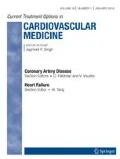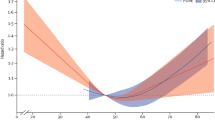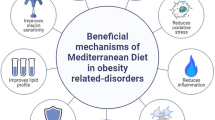Optional statement
Cardiovascular disease (CVD) accounts for almost 50% of all deaths in industrialized nations. As much as 70% of CVD can be prevented or delayed with dietary choices and lifestyle modifications. Western-style diets, sedentary lifestyles, and cigarette smoking are key modifiable CVD risk factors. Although CVD mortality was trending downward for almost 50 years, a resurgence, both nationally and globally, has occurred. A growing epidemic of obesity (“globesity”), decreasing physical activity, and persistent cigarette smoking are major behavioral factors underlying this change. Diet and lifestyle increase CVD risk both directly and indirectly. Direct effects include biological, molecular, and physiologic alterations, including inflammatory stimuli and oxidative stresses. Indirect effects include diabetes, dyslipidemias, and hypertension. However, trials studying links between diet and CVD remain notoriously difficult to execute and interpret. Diet interventions are typically confounded by other aspects of an overall diet as well as by lifestyle. Furthermore, benefits derived from a specific dietary or lifestyle intervention may not be proportional to the degree of risk posed by the unhealthy diet or lifestyle. Nonetheless, therapeutic rationale for diet and lifestyle are supported by basic and clinical research. Key components of a healthy aggregate diet include 1) reduced caloric intake; 2) reduced total fat, saturated fat, trans fat, and cholesterol with proportional increases in monosaturated, n-3 (omega-3), and n-6 fatty acids; 3) increased dietary fiber, fruit, and vegetables; 4) increased micronutrients (eg, folate, B6, B12); 5) increased plant protein in lieu of animal protein; 6) reduced portions of highly processed foods; and 7) adopting a more Mediterranean or “prudent” dietary pattern over the prevailing “western” dietary pattern. Key lifestyle interventions include increased physical activity and smoking cessation. Translation of the benefits of healthy diet and lifestyle to the wider population requires both individual and public health strategies targeting at-risk groups.
Similar content being viewed by others
References and Recommended Reading
Murray CJL, Lopez AD, eds: The Global Burden of Disease. Cambridge, MA: Harvard School of Public Health; 1996.
World Health Organization, ed: Globalization, Diet, and Noncommunicable Diseases. Geneva, Switzerland: 2002:1–25. [Electronic version:6-31]. http:// www.who.int/hpr/NPH/docs/globalization. diet.and.ncds.pdf. Good perspective on the economic transition and globalization of our food supply. Emphasis is given to developing nations.
Gaziano JM: Global burden of cardiovascular disease. In Braunwald’s Heart Disease: A Textbook of Cardiovascular Medicine, edn 6, vol 2. Edited by Braunwald E, et al. Philadelphia: WB Saunders; 2005:1–19. An excellent historical epidemiologic summary.
Centers for Disease Control and Prevention (CDC): Decline in deaths from heart disease and stroke—United States, 1900–1999. MMWR Morb Mortal Wkly Rep 1999, 48:649–656.
Stampfer MJ, Hu FB, Manson JE, et al.: Primary prevention of coronary heart disease in women through diet and lifestyle. N Engl J Med 2000, 343:16–22.
Gaziano JM, Manson JE, Ridker PM: Primary and secondary prevention of coronary artery disease. In Braunwald’s Heart Disease: A Textbook of Cardiovascular Medicine, edn 6, vol 2. Edited by Braunwald E, et al. Philadelphia: WB Saunders; 2005:1057–1082. A sound and excellent review on primary and secondary prevention.
Pearson TA, McBride PE, Miller NH, Smith SC: 27th Bethesda Conference: Matching the intensity of risk factor management with the hazard for coronary disease events. Task Force 8. Organization of preventive cardiology service. J Am Coll Cardiol 1996, 27:1039–1047.
Keys A, Aravanis C, Blackburn H, eds: Seven Countries. A Multivariate Analysis of Death and Coronary Heart Disease. Cambridge, MA: Harvard University Press; 1980:1–381.
Kannel WB, Dawber TR, Kagan A, et al.: Factors of risk in the development of coronary heart disease—sixyear follow-up experience: the Framingham Study. Ann Intern Med 1961, 55:33–50.
Hu FB, Willett WC: Diet, nutrition, and coronary heart disease. In Cardiovascular Health and Disease in Women, edn 2. Edited by Douglas PS. Philadelphia: WB Saunders; 2002:71–92.
Keys A: Effects on different dietary fats on plasmalipid levels. Lancet 1965, 17:318–319.
Hegsted DM, McGandy RB, Myers ML, Stare FJ: Quantitative effects of dietary fat on serum cholesterol in man. Am J Clin Nutr 1965, 17:281–295.
McNamara DJ, Kolb R, Parker TS, et al.: Heterogeneity of cholesterol homeostasis in man. Response to changes in dietary fat quality and cholesterol quantity. J Clin Invest 1987, 79:1729–1739.
Mattson FH, Grundy SM: Comparison of effects of dietary saturated, monounsaturated, and polyunsaturated fatty acids on plasma lipids and lipoproteins in man. J Lipid Res 1985, 26:194–202.
HuFB, Willett WC: Optimal diets for prevention of coronary heart disease. JAMA 2002, 288:2569–2578. A landmark review on diet and heart disease.
Vermunt SHF, Mensink RP: Health effects of trans fatty acids. In Primary and Secondary Preventive Nutrition. Edited by Bendich A, Deckelbaum R. Totowa, NJ: Humana Press; 2001:3–17. An excellent review on trans fats—their origins and disease relationships.
Willett WC, ed: Eat, Drink, and Be Healthy: the Harvard Medical School Guide to Healthy Eating. New York: Simon and Schuster; 2001. Excellent consumer guide; a sound introductory reference for the primary care physician who desires to navigate the nutrition maze.
Liu S, Willett WC, Stampfer MJ, et al.: A prospective study of dietary glycemic load, carbohydrate intake, and risk of coronary heart disease in US women. Am J Clin Nutr 2000, 71:1455–1461.
Hu FB: Plant-based foods and prevention of cardiovascular disease: an overview. Am J Clin Nutr 2003, 78(3 suppl):544S-551S.
Liu S, Lee IM, Ajani U, et al.: Intake of vegetables rich in carotenoids and risk of coronary heart disease in men: the Physicians’ Health Study. Int J Epidemiol 2001, 30:130–135.
Joshipura KJ, Hu FB, Manson JE, et al.: The effect of fruit and vegetable intake on risk for coronary heart disease. Ann Intern Med 2001, 134:1106–1114.
Joshipura KJ, Ascherio A, Manson JE, et al.: Fruit and vegetable intake in relation to risk of ischemic stroke. JAMA 1999, 282:1233–1239.
Gey KF, Brubacher GB, Stahelin HB: Plasma levels of antioxidant vitamins in relation to ischemic heart disease and cancer. Am J Clin Nutr 1987, 45:1368S-1377S.
HuFB: Dietary pattern analysis: a new direction in nutritional epidemiology. Curr Opin Lipidol 2002, 13:3–9. Excellent introduction to the study of dietary patterns-disease relationships.
Trichopoulou A, Costacou T, Bamia C, Trichopoulos D: Adherence to a Mediterranean diet and survival in a Greek population. N Engl J Med 2003, 348:2599–2608. An important reminder that people eat food, not nutrients. It underscores the importance of the total diet in real-life settings compared with single-nutrient analyses.
Willett WC, ed.: Nutritional Epidemiology. Oxford: Oxford University Press; 1998:377–466. Essential reading for understanding the nuts and bolts of nutrition research.
Kerver JM, Yang EJ, Bianchi L, Song WO: Dietary patterns associated with risk factors for cardiovascular disease in healthy US adults. Am J Clin Nutr 2003, 78:1103–1110.
van Dam RM, Grievink L, Ocke MC, Feskens EJ: Patterns of food consumption and risk factors for cardiovascular disease in the general Dutch population. Am J Clin Nutr 2003, 77:1156–1163.
Esposito K, Marfella R, Ciotola M, et al.: Effect of a Mediterranean-style diet on endothelial dysfunction and markers of vascular inflammation in the metabolic syndrome: a randomized trial. JAMA 2004, 292:1440–1446.
Singh RB, Dubnov G, Niaz MA, et al.: Effect of an Indo-Mediterranean diet on progression of coronary artery disease in high risk patients (Indo-Mediterranean Diet Heart Study): a randomized single-blind trial. Lancet 2002, 360:1455–1461.
Appel LJ, Moore TJ, Obarzanek E, et al.: A clinical trial of the effects of dietary patterns on blood pressure. DASH Collaborative Research Group. N Engl J Med 1997, 336:1117–1124.
Renaud S, de Lorgeril M, Delaye J, et al.: Cretan Mediterranean diet for prevention of coronary heart disease. Am J Clin Nutr 1995, 61:1360S-1367S.
de Lorgeril M, Renaud S, Mamelle N, et al.: Mediterranean alpha-linolenic acid-rich diet in secondary prevention of coronary heart disease. Lancet 1994, 343:1454–1459.
Singh RB, Rastogi SS, Verma R, et al.: Randomised controlled trial of cardioprotective diet in patients with recent acute myocardial infarction: results of one-year follow up. BMJ 1992, 304:1015–1019.
Osler M, Heitmann BL, Gerdes LU, et al.: Dietary patterns and mortality in Danish men and women: a prospective observational study. Br J Nutr 2001, 85:219–225.
Fung TT, Willett WC, Stampfer MJ, et al.: Dietary patterns and the risk of coronary heart disease in women. Arch Intern Med 2001, 161:1857–1862.
Hu FB, Rimm EB, Stampfer MJ, et al.: Prospective study of major dietary patterns and risk of coronary heart disease in men. Am J Clin Nutr 2000, 72:912–921.
Lopez-Garcia E, Schulze MB, Manson JE, et al.: Consumption of (n-3) fatty acids is related to plasma biomarkers of inflammation and endothelial activation in women. J Nutr 2004, 134:1806–1811.
Flegal KM, Carroll MD, Kuczmarski RJ, Johnson CL: Overweight and obesity in the United States: prevalence and trends, 1960–1994. Int J Obes Relat Metab Disord 1998, 22:39–47.
Glendening PN, Hearne SA, Segal MA, et al.: Trust for America’s Health. F as in fat: How Obesity Policies are Failing in America. Issue report. August 2005. http:// healthyamericans.org/reports/obesity2005/. A provocative review and a good (sometimes alarming) read.
Harnack LJ, Jeffery RW, Boutelle KN: Temporal trends in energy intake in the United States: an ecologic perspective. Am J Clin Nutr 2000, 71:1478–1484.
Allison DB, Fontaine KR, Manson JE, et al.: Annual deaths attributable to obesity in the United States. JAMA 1999, 282:1530–1538.
Van Gaal LF, Wauters MA, De Leeuw IH: The beneficial effects of modest weight loss on cardiovascular risk factors. Int J Obes 1997, 21:S5-S9.
Freeman MR, King J, Kennedy E: Popular diets: a scientific review. Obes Res 2001, 9(suppl_1):1S-40S. Comprehensive overview of popular diets.
U.S. Department of Health and Human Services: Physical Activity and Health: A Report of the Surgeon General. Atlanta, GA: U.S. Department of Health and Human Services, Centers for Disease Control and Prevention, National Center for Chronic Disease Prevention and Health Promotion; 1996.
Paffenbarger RS Jr, Hyde RT, Wing AL, et al.: The association of changes in physical-activity level and other lifestyle characteristics with mortality among men. N Engl J Med 1993, 328:538–545.
Tanasescu M, Leitzmann MF, Rimm EB, et al.: Exercise type and intensity in relation to coronary heart disease in men. JAMA 2002, 288:1994–2000.
Oldridge NB, Guyatt GH, Fischer ME, Rimm AA: Cardiac rehabilitation after myocardial infarction. Combined experience of randomized clinical trials. JAMA 1988, 260:945–950.
Bulwer BE: Sedentary lifestyles, physical activity, and cardiovascular disease: from research to practice. Crit Path Cardiol 2004, 3:184–193.
Centers for Disease Control and Prevention (CDC): Cigarette smoking among adults—United States, 2000. MMWR Morb Mortal Wkly Rep 2002, 51:642–645.
Centers for Disease Control and Prevention (CDC): Annual smoking—attributable mortality, years of potential life lost, and economic costs: United States, 1995–1999. MMWR Morb Mortal Wkly Rep 2002, 51:300–303.
Thomson CC, Rigotti NA: Hospital- and clinic-based smoking cessation interventions for smokers with cardiovascular disease. Prog Cardiovasc Dis 2003, 45:459–479.
Author information
Authors and Affiliations
Rights and permissions
About this article
Cite this article
Forman, D., Bulwer, B.E. Cardiovascular disease: Optimal approaches to risk factor modification of diet and lifestyle. Curr Treat Options Cardio Med 8, 47–57 (2006). https://doi.org/10.1007/s11936-006-0025-7
Issue Date:
DOI: https://doi.org/10.1007/s11936-006-0025-7




